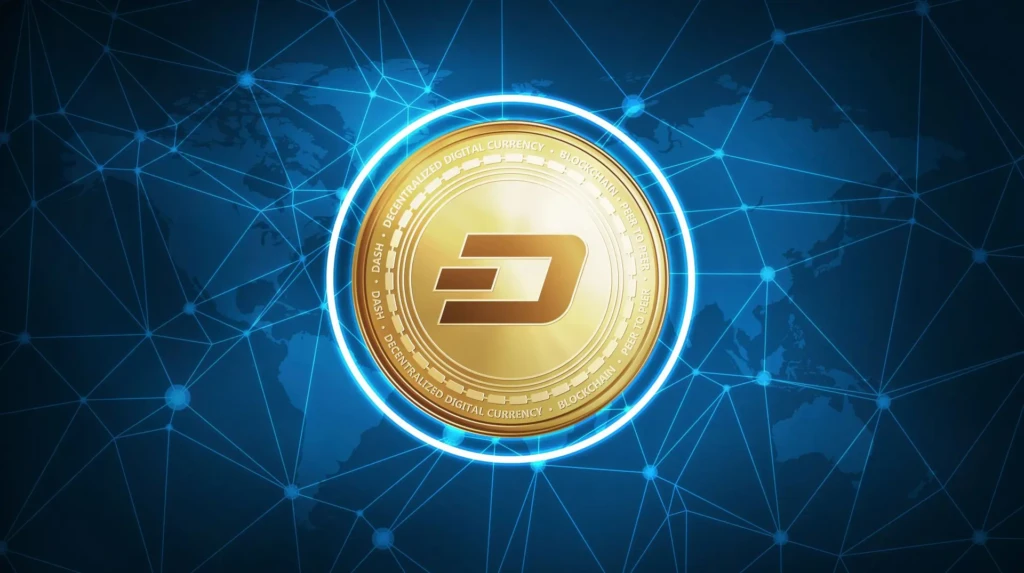How Does Dash Cryptocurrency Work?
How does Dash cryptocurrency work, and what makes it stand out in a crowded field of digital assets? Born in 2014 as a fork of Bitcoin, Dash—short for Digital Cash—was designed to fix Bitcoin’s speed and privacy limitations. Over a decade later, Dash remains a case study in how innovative governance, fast transactions, and a self-funded treasury can reshape decentralized finance.
This article investigates Dash’s architecture, economics, and global footprint, highlighting how the project’s dual-layer network, incentivized nodes, and community funding combine to create a distinctive cryptocurrency ecosystem.
Dash’s Origin Story
Dash began as XCoin, rebranded to Darkcoin in early 2014, and finally adopted the name Dash in 2015 to emphasize its mission as “digital cash.” Its founders aimed to address two key Bitcoin shortcomings: slow transaction confirmations and limited privacy. Dash’s open-source code remains a Bitcoin derivative, but with critical upgrades.
Key Innovations at Launch
- Faster Transactions: Dash set out to process payments nearly instantly, targeting everyday consumer use.
- Optional Privacy: Through its PrivateSend feature, users could mix coins for added anonymity.
- Self-Governance: Dash pioneered a decentralized autonomous organization (DAO) model to fund development and marketing directly from its blockchain.
Core Architecture: The Two-Tier Network
The answer to how does Dash cryptocurrency work lies in its unique two-layer structure.
Layer One: Miners
Like Bitcoin, Dash uses proof-of-work mining to secure the blockchain and validate transactions. Miners receive 45% of the block reward for their work.
Layer Two: Masternodes
The second layer is Dash’s defining feature. Masternodes are special servers requiring a collateral stake of 1,000 DASH. They provide advanced services, including:
- InstantSend: Near-instant settlement by locking transactions within seconds.
- ChainLocks: Protection against 51% attacks through rapid finality.
- Governance Voting: Masternodes vote on budget proposals and network changes.
This dual system balances security with speed, giving Dash an edge in real-time payments.
Transaction Mechanics
When a user sends Dash, the transaction first propagates to miners. If InstantSend is enabled, masternodes immediately lock the inputs, ensuring the funds can’t be double-spent. Blocks are still mined roughly every 2.5 minutes—four times faster than Bitcoin—providing swift confirmation.
Privacy with PrivateSend
Dash once garnered headlines for its PrivateSend feature, which mixes coins through masternodes to obscure transaction trails. While regulators have scrutinized privacy coins, Dash insists that PrivateSend simply uses standard coin-join techniques rather than true anonymity tech like Monero’s ring signatures.
Governance and Treasury System
Perhaps the most forward-thinking aspect of how Dash cryptocurrency works is its self-funding DAO. Every block allocates 10% of rewards to a community treasury. Masternodes vote on proposals—marketing campaigns, software upgrades, business partnerships—creating a self-sustaining ecosystem without reliance on venture capital or donations.
- Example Proposal: Funding merchant adoption programs in Latin America.
- Outcome: Continuous development and outreach even through bear markets.
Economic Model and Supply
Dash’s maximum supply is capped at 18.9 million coins, with block rewards declining by roughly 7% annually. Rewards are split as follows:
- 45% miners
- 45% masternodes
- 10% treasury
This distribution incentivizes both security and governance participation.
Real-World Adoption
Dash has focused heavily on everyday payments, especially in regions with volatile fiat currencies.
Latin American Footprint
Venezuela has been a key market, with Dash accepted by retailers and remittance providers. Partnerships with payment processors like Bitrefill have expanded its global reach.
Merchant Tools
DashPay wallets and point-of-sale integrations enable seamless consumer experiences, aiming to fulfill the “digital cash” promise.
Regulatory Landscape
Despite its privacy roots, Dash has worked to shed the “privacy coin” label to avoid delistings. It complies with major exchange requirements and highlights the optional nature of PrivateSend.
For current regulatory perspectives, see the U.S. Financial Crimes Enforcement Network guidance on virtual currencies.
Security Considerations
Dash’s ChainLocks feature drastically reduces the risk of a 51% attack by finalizing blocks within seconds. Masternode collateral requirements make attacks costly. However, like any proof-of-work blockchain, mining centralization and software bugs remain theoretical risks.
Comparing Dash to Competitors
- Bitcoin: Dash confirms transactions faster and offers optional privacy but has a smaller network effect.
- Litecoin: Both focus on payments, but Dash’s governance treasury adds a funding advantage.
- Monero/Zcash: Stronger privacy but less merchant adoption.
FAQs: How Does Dash Cryptocurrency Work?
How does Dash cryptocurrency work in simple terms?
Dash operates on a two-tier blockchain where miners secure the network and masternodes enable instant, private transactions.
How does Dash cryptocurrency work for instant payments?
Masternodes lock transactions through InstantSend, allowing merchants to accept payments within seconds.
How does Dash cryptocurrency work with governance decisions?
Masternodes vote on proposals funded by the 10% treasury, guiding development and marketing.
How does Dash cryptocurrency work compared to Bitcoin?
Dash confirms blocks faster, supports optional privacy, and features a built-in funding mechanism absent in Bitcoin.
Forward-Looking Analysis
Dash’s decade-long experiment in decentralized governance offers lessons for the broader crypto economy. While competition from stablecoins and regulatory pressure challenge its original vision, Dash continues to innovate with mobile-first wallets and Layer-2 payment solutions.
Whether Dash can reclaim significant market share depends on merchant adoption and evolving regulations. Yet the core question—how does Dash cryptocurrency work—reveals a resilient network blending speed, governance, and self-funding in ways many projects still struggle to achieve.

